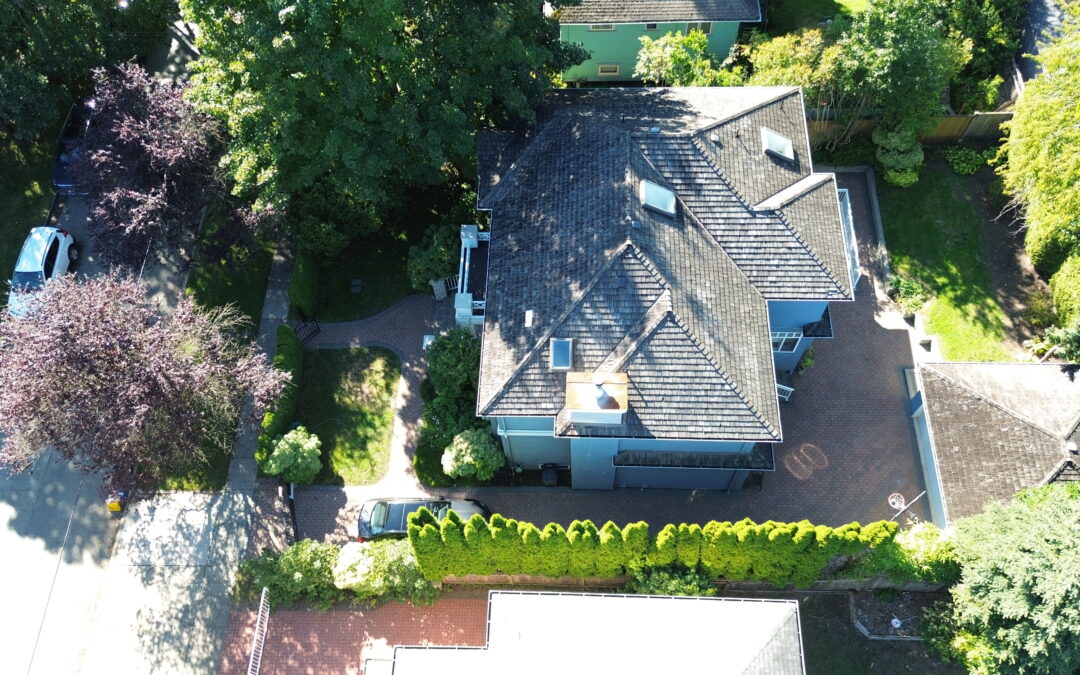When it comes to protecting your home, few things are as important as your roof. But even the strongest roofing system can suffer from unexpected roof damage—especially when trees or large branches come crashing down during a storm.
A single fallen limb can lead to serious problems, from leaks and cracks to structural issues that require costly roof repairs or even a complete roof replacement. Fortunately, there are ways to prevent this from happening.
In this blog, we’ll share seven smart strategies to prevent roof damage caused by falling trees and branches—so you can keep your home safe and your roof in top condition.
Why Falling Trees Are a Big Cause of Roof Damage
Trees can add beauty and shade to your yard, but when they’re too close to your home, they can become a real danger. Overhanging branches, weak roots, or dead trees can fall without warning—and when they do, the result is often serious roof damage.
Environment Canada issues wind warnings when steady winds hit 70 km/h or more, or when gusts go over 90 km/h. These kinds of storms are pretty common across Canada, especially in the fall and winter. Strong winds like that can easily snap large limbs or knock over entire trees—especially when the ground is soft from heavy rain.
Sometimes, the damage isn’t as dramatic as a tree crashing through your roof. Even smaller branches can scrape your shingles, break pieces off, or block your gutters. Over time, that kind of wear and tear can lead to leaks, hidden water issues, and unexpected roof repairs or even a full roof replacement if the problem is ignored for too long.
7 Proven Tips to Prevent Roof Damage from Trees and Branches
1. Keep an Eye on Trees Around Your Home
Take a quick walk around your yard every now and then, especially before storm season. Look at the trees close to your house. Are there dead branches? Cracks in the trunk? Limbs hanging over your roof? Any signs of rot or disease?
These might seem small, but they’re often the first signs that a tree could fall or drop a limb—leading to serious roof damage when bad weather rolls in.
2. Cut Back Branches Before They Wreck Your Roof
Those branches hanging over your roof might not seem like a big deal—until a storm hits. One strong gust of wind, and they could snap, scrape off shingles, or even punch a hole through the roof.
To save yourself from future roof repairs or a costly roof replacement, make sure branches are trimmed back at least six feet from your roof. It’s an easy fix that can prevent major roofing repair headaches later on.
3. Cut Down Dying Trees Before They Wreck Your Roof
Got a tree that’s leaning too much, looks hollow, or is clearly on its last leg? Don’t wait until it crashes down. Taking it out now will cost a lot less than paying for roof damage later.
The BC Ministry of Forests, through its FireSmart program, recommends removing any trees that are dead, unstable, or too close to your home or power lines. It’s one of the easiest ways to avoid big repairs and safety risks.
4. Give Your Roof a Fighting Chance
If your home sits under big trees, reinforcing your roof is a smart move. Simple upgrades—like hurricane clips, stronger plywood, or tougher shingles—can really help if a heavy branch ever comes down.
And if your house is on the older side, a little extra support now might save you from needing a full roof replacement after the next storm.
5. Clean Off Debris Before It Causes Trouble
Leaves, sticks, and pine needles might seem harmless, but when they pile up, they trap moisture. That’s when trouble starts—think mold, rot, and hidden roof damage that sneaks up over time.
Clogged gutters can also cause water to back up under your shingles, which often leads to leaks and the need for roofing repair or bigger roof repairs later on. A quick clean-up now can save you a lot of hassle down the road.
6. Choose Strong Roofing Materials to Help Prevent Roof Damage
Today’s roofing materials are built to handle more than just rain—they can also protect your home from falling branches and flying debris during storms. If you want extra peace of mind, consider using:
- Class 4 impact-rated shingles
- Metal roofing
- Rubber or synthetic materials
These options are made to take a hit without cracking or breaking, which helps lower the risk of roof damage during rough weather. Just make sure the materials meet Canadian Construction Materials Centre (CCMC) standards so you know they’re up to code.
7. Call a Roofing Expert if You Think Your Roof is Damaged
Did you hear a loud bang during a storm? Or maybe you spotted a few shingles missing after some strong winds? Don’t wait and hope it goes away. Even minor signs of roof damage can turn into bigger, more expensive problems if ignored.
A trusted roofer can take a look and let you know if it’s something small that needs a quick fix—or if you’re looking at more serious roof repairs or even a roof replacement.
What to Do If a Tree Falls and Damages Your Roof
Sometimes, no matter how careful you are, things go wrong—like when a tree or heavy branch crashes down during a storm. If that happens, here’s what to do:
- Make sure everyone’s safe – If the damage looks bad or you’re unsure how stable the roof is, it’s best to get out of the house until things are checked.
- Take photos of the damage – Snap a few clear pictures (from a safe spot). These will be important when you file your insurance claim.
- Call your insurance company – Let them know what happened and ask about your next steps.
- Get a roofer on-site ASAP – A reliable roofing contractor can take a look, prevent things from getting worse, and walk you through repair options.
If the roof damage isn’t too serious, a quick fix might be enough. But if it took a real beating, you could be looking at a full roof replacement.
Final Thoughts: Keep Roof Damage From Catching You Off Guard
Dealing with roof repairs after a storm isn’t fun—so the best move is to get ahead of the problem. Trim back any risky trees, check your yard regularly, and make sure your roof’s built to handle the weather.
Following these seven tips can help you avoid surprise roof repairs, extend your roof’s life, and save you stress when the next storm rolls in.
And remember—trees aren’t the only things that can wreck your roof. If you’re curious about the other big causes of roof damage, don’t miss this guide: What Causes the Most Roof Damage? 7 Important Things You Need to Know.
Not sure if your roof’s in good shape? It’s always a smart idea to have someone local check it out. Catching problems early means fewer headaches—and smaller repair bills—down the road.

